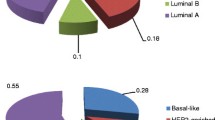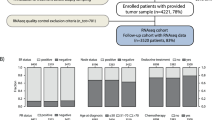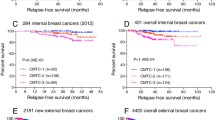Abstract
The goal of improving systemic treatment of breast cancers is to evolve from treating every patient with non-specific cytotoxic chemotherapy/hormonal therapy, to a more individually-tailored direct treatment. Although anatomic staging and histological grade are important prognostic factors, they often fail to predict the clinical course of this disease. This study aimed to develop a gene expression profile associated with breast cancers of differing grades. We extracted mRNA from FFPE archival breast IDC tissue samples (Grades I–III), including benign tumours. Affymetrix GeneChip® Human Genome U133 Plus 2.0 Arrays were used to determine gene expression profiles and validated by Q-PCR. IHC was used to detect the AXIN2 protein in all tissues. From the array data, an independent group t-test revealed that 178 genes were significantly (P ≤ 0.01) differentially expressed between three grades of malignant breast tumours when compared to benign tissues. From these results, eight genes were significantly differentially expressed in more than one comparison group and are involved in processes implicated in breast cancer development and/or progression. The two most implicated candidates genes were CLD10 and ESPTI1 as their gene expression profile from the microarray analysis was replicated in Q-PCR analyses of the original tumour samples as well as in an extended population. The IHC revealed a significant association between AXIN2 protein expression and ER status. It is readily acknowledged and established that significant differences exist in gene expression between different cancer grades. Expansion of this approach may lead to an improved ability to discriminate between cancer grade and other pathological factors.





Similar content being viewed by others
Abbreviations
- AGRF:
-
Australian Genome Research Facility
- ANOVA:
-
Analysis of variance
- APC :
-
Adenomatosis Polyposis Coli Gene
- AXIN2 :
-
Axin 2 Gene
- Bp :
-
Base pair
- CDC42EP3 :
-
CDC42 effector protein 3
- CLD10 :
-
Claudin 10
- CXCL16 :
-
Chemokine ligand 16
- DNA:
-
Deoxyribonucleic acid
- dNTPs:
-
Deoxynucleotide triphosphate
- EPSTI1 :
-
Epithelial stromal interaction 1
- ER:
-
Estrogen receptor
- FFPE:
-
Formalin-fixed paraffin-embedded
- GAPDH :
-
Glyceraldehyde 3-phosphate dehydrogenase gene
- H&E:
-
Haematoxylin and eosin
- IDC:
-
Invasive ductal carcinoma
- mRNA:
-
Messenger ribonucleic acid
- PALMD :
-
Palmdelphin
- Q-PCR:
-
Quantitative real time polymerase chain reaction
- RNA:
-
Ribonucleic acid
- RPL13A :
-
Ribosomal Protein Ligand 13A Gene
- SRW:
-
Stephen R. Weinstein
- TCEA3 :
-
Transcription elongation factor 3
- ZAN :
-
Zonadhesin
References
Sutherland RL, Musgrove EA (2002) Cyclin D1 and mammary carcinoma: new insights from transgenic mouse models. Breast Cancer Res 4(1):14–17
Zhang DH et al (2003) Tissue microarray study for classification of breast tumors. Life Sci 73(25):3189–3199
Perreard L et al (2006) Classification and risk stratification of invasive breast carcinomas using a real-time quantitative RT-PCR assay. Breast Cancer Res 8(2):R23
Ma XJ et al (2003) Gene expression profiles of human breast cancer progression. Proc Natl Acad Sci USA 100(10):5974–5979
Sotiriou C et al (2002) Gene expression profiles derived from fine needle aspiration correlate with response to systemic chemotherapy in breast cancer. Breast Cancer Res 4(3):R3
Desai KV et al (2002) Chipping away at breast cancer: insights from microarray studies of human and mouse mammary cancer. Endocr Relat Cancer 9(4):207–220
Gabrovska PN et al (2010) Gene expression profiling in human breast cancer—toward personalised therapeutics? The Open Breast Cancer J 2:46–59
Nambiar PR et al (2005) Global gene expression profiling: a complement to conventional histopathologic analysis of neoplasia. Vet Pathol 42(6):735–752
Miller LD, Liu ET (2007) Expression genomics in breast cancer research: microarrays at the crossroads of biology and medicine. Breast Cancer Res 9(2):206
Cekan SZ (2004) Methods to find out the expression of activated genes. Reprod Biol Endocrinol 2:68
Smith RA et al (2007) Progesterone, glucocorticoid, but not estrogen receptor mRNA is altered in breast cancer stroma. Cancer Lett 18(255):77–84
Gabrovska PN et al (2011) Genes involved in Wnt signalling are associated with more aggressive human breast tumours. Cancer Letters
Smyth GK (2004) Linear models and empirical Bayes methods for assessing differential expression in microarray experiments. Stat Appl Genet Mol Biol 3:3
Haupt LM et al (2009) The heparan sulfate proteoglycan (HSPG) glypican-3 mediates commitment of MC3T3–E1 cells toward osteogenesis. J Cell Physiol 220(3):780–791
Cheung ST et al (2005) Claudin-10 expression level is associated with recurrence of primary hepatocellular carcinoma. Clin Cancer Res 11(2 Pt 1):551–556
Inai T et al (2005) Heterogeneity in expression and subcellular localization of tight junction proteins, claudin-10 and -15, examined by RT-PCR and immunofluorescence microscopy. Arch Histol Cytol 68(5):349–360
Qin M et al (2003) Suppression subtractive hybridization identifies distinctive expression markers for coronary and internal mammary arteries. Arterioscler Thromb Vasc Biol 23(3):425–433
Gouon-Evans V, Lin EY, Pollard JW (2002) Requirement of macrophages and eosinophils and their cytokines/chemokines for mammary gland development. Breast Cancer Res 4(4):155–164
Gotzmann J et al (2004) Molecular aspects of epithelial cell plasticity: implications for local tumor invasion and metastasis. Mutat Res 566(1):9–20
Gudjonsson T et al (2003) To create the correct microenvironment: three-dimensional heterotypic collagen assays for human breast epithelial morphogenesis and neoplasia. Methods 30(3):247–255
Petersen OW et al (2003) Epithelial to mesenchymal transition in human breast cancer can provide a nonmalignant stroma. Am J Pathol 162(2):391–402
Minami M et al (2001) Expression of SR-PSOX, a novel cell-surface scavenger receptor for phosphatidylserine and oxidized LDL in human atherosclerotic lesions. Arterioscler Thromb Vasc Biol 21(11):1796–1800
Shimaoka T et al (2003) Cutting edge: SR-PSOX/CXC chemokine ligand 16 mediates bacterial phagocytosis by APCs through its chemokine domain. J Immunol 171(4):1647–1651
Kume N (2002) New oxidized LDL receptors and their functions in atherogenesis. Nippon Ronen Igakkai Zasshi 39(3):264–267
Guiducci C et al (2004) Intralesional injection of adenovirus encoding CC chemokine ligand 16 inhibits mammary tumor growth and prevents metastatic-induced death after surgical removal of the treated primary tumor. J Immunol 172(7):4026–4036
Vaday GG et al (2004) CXCR4 and CXCL12 (SDF-1) in prostate cancer: inhibitory effects of human single chain Fv antibodies. Clin Cancer Res 10(16):5630–5639
Scala S et al (2005) Expression of CXCR4 predicts poor prognosis in patients with malignant melanoma. Clin Cancer Res 11(5):1835–1841
Hirsch DS, Pirone DM, Burbelo PD (2001) A new family of Cdc42 effector proteins, CEPs, function in fibroblast and epithelial cell shape changes. J Biol Chem 276(2):875–883
Spik A et al (2006) Human fertility protein PUMILIO2 interacts in vitro with testis mRNA encoding Cdc42 effector 3 (CEP3). Reprod Biol 6(2):103–113
Gasper J, Swanson WJ (2006) Molecular population genetics of the gene encoding the human fertilization protein zonadhesin reveals rapid adaptive evolution. Am J Hum Genet 79(5):820–830
Fish RN, Kane CM (2002) Promoting elongation with transcript cleavage stimulatory factors. Biochim Biophys Acta 1577(2):287–307
Pokholok DK, Hannett NM, Young RA (2002) Exchange of RNA polymerase II initiation and elongation factors during gene expression in vivo. Mol Cell 9(4):799–809
Hu B et al (2005) Molecular characterization and immunohistochemical localization of palmdelphin, a cytosolic isoform of the paralemmin protein family implicated in membrane dynamics. Eur J Cell Biol 84(11):853–866
Wang X et al (2008) Association of genetic variation in genes implicated in the beta-catenin destruction complex with risk of breast cancer. Cancer Epidemiol Biomarkers Prev 17(8):2101–2108
Yook JI et al (2006) A Wnt-Axin2-GSK3beta cascade regulates Snail1 activity in breast cancer cells. Nat Cell Biol 8(12):1398–1406
Leung JY et al (2002) Activation of AXIN2 expression by beta-catenin-T cell factor. A feedback repressor pathway regulating Wnt signaling. J Biol Chem 277(24):21657–21665
Lustig B et al (2002) Negative feedback loop of Wnt signaling through upregulation of conductin/axin2 in colorectal and liver tumors. Mol Cell Biol 22(4):1184–1193
Acknowledgments
P.N.G. was funded by a Griffith University Postgraduate Research Scholarship. The authors thank the Gold Coast Hospital Department of Pathology, and the patients from whom samples were obtained.
Author information
Authors and Affiliations
Corresponding author
Electronic supplementary material
Below is the link to the electronic supplementary material.
Rights and permissions
About this article
Cite this article
Gabrovska, P.N., Smith, R.A., Tiang, T. et al. Development of an eight gene expression profile implicating human breast tumours of all grade. Mol Biol Rep 39, 3879–3892 (2012). https://doi.org/10.1007/s11033-011-1167-6
Received:
Accepted:
Published:
Issue Date:
DOI: https://doi.org/10.1007/s11033-011-1167-6




